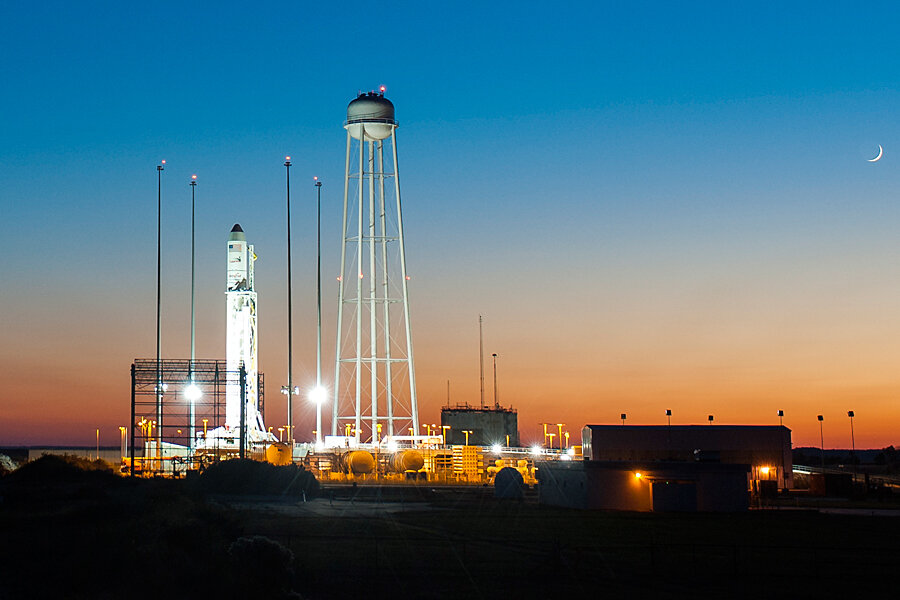How to watch Antares rocket launch tonight – and also see space station
Loading...
Orbital Sciences' third formal cargo mission to the International Space Station (ISS) is set for launch early Monday evening, with the potential to provide people along the Eastern Seaboard with one part of a spectacular celestial show, weather permitting.
The launch is slated for 6:45 p.m. EDT from the Mid-Atlantic Regional Spaceport on Virginia's Wallops Island. Forecasters anticipate a 98 percent chance that the weather will be just fine for the launch.
[Update: Monday night's launch was scrubbed because of a stray boat in the launch safety range. It has been rescheduled for 5:30 p.m. EDT on Tuesday. You can watch a live webcast of the launch here.
It's “the first time I've ever seen a 98 percent chance of go” from a forecaster, said former NASA astronaut Frank Culbertson Jr., now executive vice president and general manager of the company's advanced programs group, during a pre-launch briefing on Sunday.
Up and down the East Coast, forecasters are calling for partly cloudy or mostly clear skies, allowing people from the Carolinas to southeastern Massachusetts to see portions of the ascent of Orbital's Antares resupply rocket. About five minutes after Antares lifts off, the space station itself will become visible – rising from the west-northwest to trace an easterly arc over a crescent moon, with Mars close on its heels as the moon and the red planet set.
Orbital's Cygnus cargo capsule is scheduled to rendezvous with the space station on Sunday.
Ordinarily, cargo missions that Orbital Sciences and Space Exploration Technologies (SpaceX) loft for the National Aeronautics and Space Administration arrive at the station two to three days after launch. Cygnus, however, will have to loiter for several days some 370 to 740 miles behind the station – a testament to how busy the space station has become.
On Saturday, SpaceX's Dragon cargo capsule left the station for a Pacific splashdown after arriving at the station Sept. 23. A European cargo craft, an automated transfer vehicle (ATV), is berthed at the station. A Russian Progress resupply capsule was slated to leave the station Monday, with another scheduled to arrive Wednesday. And the station currently has two Russian Soyuz crew capsules docked to it.
At the moment, this is the closest that low-Earth orbit has to Chicago's O'Hare International Airport.
“That's quite a bit of visiting-vehicle traffic,” said Gerald Esquivel, NASA's visiting integration manager for the Orbital-ISS missions. Once the Progress capsule leaves on Wednesday, astronauts aboard the station will prepare for Cygnus' arrival.
Cygnus is carrying 2-1/2 tons of science experiments, crew supplies, and hardware to the station – including a tank filled with pressurized nitrogen for the station's airlock system. Filled to a pressure of 6,000 pounds per square inch, the three-foot-long tank is the most highly pressurized tank that Cygnus has carried.
The science experiments that the craft is carrying range from a student experiment that tests for the best mix of light colors to enhance plant growth to a system designed to monitor meteors as they enter Earth's atmosphere.
Run by the Southwest Research Institute's office in Boulder, Colo., that experiment will analyze the chemical composition of meteors as they burn up – space-based measurements that will observe meteors continuously and pick up the signature of organic carbon in the meteor trails, something difficult to detect from Earth.
Indeed, the ATV docked at the station will become the test subject for another experiment – instruments designed to take a range of measurements throughout the ATV as it reenters the atmosphere and incinerates. The goal is to gather information that will lead to better predictions of how reentering spacecraft break up on reentry.
Cygnus is currently scheduled to leave the station Dec. 3, bearing about 5,000 pounds of refuse that will burn up with the craft on reentry.








